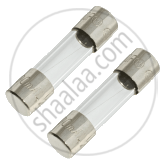Advertisements
Advertisements
प्रश्न
Derive the expression for the heat produced due to a current 'I' flowing for a time interval 't' through a resistor 'R' having a potential difference 'V' across its ends. With which name is this relation known?
उत्तर
Since a conductor offers resistance to the flow of current, some work must be done by the current continuously to keep itself flowing. When an electric charge, Q moves against a potential difference, V, the amount of work done is given by:
W = Q x V (1)
From the definition of current, we know that:
Current,`I=Q/t`
So,`Q=1xxt` (2) And from Ohm's law, we have:
`V/I=R`
or `V=IxxR` (2)
Now, substituting Q = I x t and V = I x R in equation (1), we get:
W = I x t x I x R
So, the work done, W = I2 x R x t
Assuming that all the electrical work done is converted into heat energy:
Heat produced = Work done in the above equation
Thus heat produced, H = I2 x R x t joules
This is known as Joule's law of heating.
APPEARS IN
संबंधित प्रश्न
Which of the following characteristic is not suitable for a fuse wire?
(a) thin and short
(b) thick and short
(c) low melting point
(d) higher resistance than rest of wiring
Identify the figure and give its use.

Why does tungsten metal used to make solenoid type coil in an electric bulb?
Name any six domestic appliances based on the heating effect of electric current.
Answer the following question.
Write the mathematical expression for Joule's law of heating.
In an electric bulb, coil of _______ metal is used.
Which metal is used to make the filament of an electric bulb?
An electric cell produces electricity from the __________ ___________ in it.
An electric fuse is a wire made up of a material having ______ melting point.
In which of the following applications of Iron, rusting will occur most? Support your answer with valid reason.
| A | B | C | D |
 |
 |
 |
 |
